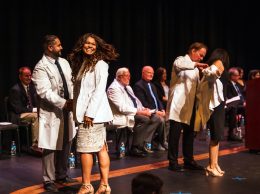Hospitals contest surgery safety rankings
IN THIS ARTICLE
- Central Coast Topic
- Patrick Kulp Author
By Patrick Kulp Friday, August 16th, 2013
Surgery safety ratings at tri-county hospitals ranged from the highest possible rank to second-to-lowest in a recent nationwide assessment released by Consumer Reports magazine, but many hospital officials dispute whether the methods used by the report accurately depict surgical quality.
Released earlier this month, the report aims to provide a generalized standard of surgical safety based on mortality rates and the share of visits that lasted longer than expected among Medicare patients.
Consumer Reports worked with health care consulting firm MPA to evaluate Medicare claims data for 27 common types of scheduled surgeries and assign a symbol to each hospital representing one of five levels of safety.
French Hospital Medical Center in San Luis Obispo was the only hospital in the region among the 22 California hospitals granted the highest score. No hospitals in the region received the lowest rating. Community Memorial hospital in Ventura and Twin Cities Community Hospital in Templeton placed in the second-lowest ranking, while the rest fell somewhere between the second- and third-highest rankings.
But officials at many of the hospitals said the simple scale alone is not detailed or extensive enough to comprehensively determine surgical safety, and the report overgeneralizes by lumping all hospitals together regardless of size or the general health of the patient populations they serve.
While the study uses the fraction of patients who end up staying in the hospital beyond the expected time frame as a next-best-available proxy measure for the rate of unforeseen complications, Cindy DeMotte, vice president of quality at Community Memorial, said this is not always a fair assumption.
DeMotte said doctors are sometimes trained to treat patients with an efficiency-centric mindset for financial reasons, but in many cases, doctors will require that patients stay longer than anticipated out of an abundance of medical caution.
DeMotte said the hospital attempted to mimic Consumer Reports’ method in order to gain some insight into Community Memorial’s below-average rating. She said CMH found that its mortality rates compared favorably to the top quartile of hospitals nationally, but the number of patients staying beyond the expected time frame exceeded the average. However, the hospital’s surgery complication rate was much lower, she said.
In many cases, ratings differed within hospitals belonging to the same health system, even those that share much of the same surgical staff. Los Robles Hospital in Thousand Oaks received an average rating, while its smaller 21-bed satellite campus Thousand Oaks Surgical Center was given the second highest rating.
Ron Yukelson, director of business development at Sierra Vista Regional Medical Center, said that despite the fact that Sierra Vista and French Hospital share the same surgeons and anesthesiologists, Sierra Vista was given an average rating, while French was given the highest rating. He said other factors such as safety standards and hospital infection rates were also approximately constant between the two.
“There just can’t be that much variation in practice among doctors. It’s curious to me how different studies get different ratings,” Yukelson said.
Maria Zate, marketing and public affairs manager at Santa Barbara-based Cottage Health System, said the difference between Goleta Valley Cottage’s above-average rating and Santa Barbara Cottage’s average rating might have to do with the relative volume of surgeries being done at each and the complexity of the cases. Santa Barbara Cottage has 408 total beds, compared to Goleta Valley’s 122.
Megan Maloney, marketing director at Dignity Health of the Central Coast, which includes Marian Regional Medical Center, French Hospital and Arroyo Grande Community Hospital, said that all three hospitals share universal protocols, procedures and safety measures, but there is some variation of practices and surgeries offered.
Yukelson said it is difficult to make a generalized comparison of hospitals of varying sizes, areas of practice and patient demographics.
While the report attempted to hold some of these factors constant by only covering commonly scheduled surgeries, the measures do not account for the overall level of health of the patients treated, he said. For example, Yukelson said, Sierra Vista’s surgical patient conditions tend to be an average of 1.5 times more severe than the state average.
“While [claims data] is risk-adjusted, it cannot capture all the facts about the severity of a patient’s condition upon entering the hospital. Sierra Vista treats a highly acute patient … many of whom have co-morbidities that don’t show up on claims data,” Yukelson said in an email.
However, Yukelson and other officials said reports like these can be useful feedback for hospital administrators and consumers alike when examined in context with other ratings and statistics.
“We use all of these to look inward and to make certain that we are following the criteria that we set out to,” Yukelson said.
When it comes to evaluating hospital safety, consumers have a range of rankings and data available to them from private and public independent organizations such as U.S. News & World Report, Healthgrades, CalHospital Compare, Leap Frog and Medicare. A large number of these standards are based on Medicare claims data because it is easily accessible and uniform across the board.
French Hospital President and CEO Alan Iftiniuk said that because organizations often lack easily comparable data across all hospitals, it is difficult to determine how much weight to give each report.
“Algorithms and models used to compute data differ and vary widely; while even the source of data, or quality of data used by any given rating organization does not always rise above question or doubt,” Iftiniuk said in an e-mailed statement.
Maloney said it is oftentimes more useful for consumers to research more detailed statistics for individual surgeries and practices at each hospital, allowing them to eliminate some of the ambiguity that might arise from generalized ratings.
Related Articles
 Friday, September 16th, 2022
Friday, September 16th, 2022










